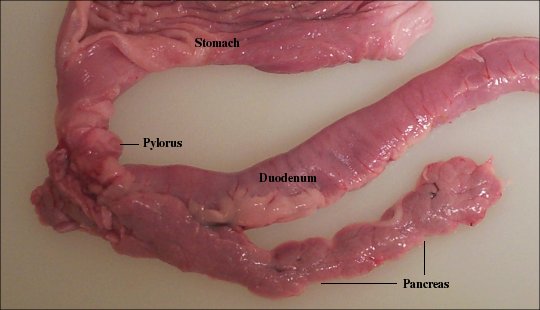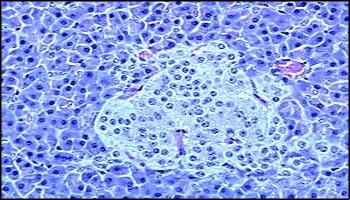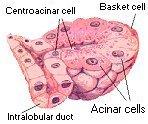VIVO Pathophysiology
Gross and Microscopic Anatomy of the Pancreas
The pancreas is a elongated organ, light tan or pinkish in color, that lies in close proximity to the duodenum. It is covered with a very thin connective tissue capsule which extends inward as septa, partitioning the gland into lobules. The image below shows a canine pancreas in relation to the stomach and duodenum.

The bulk of the pancreas is composed of pancreatic exocrine cells and their associated ducts. Embedded within this exocrine tissue are roughly one million small clusters of cells called the Islets of Langerhans, which are the endocrine cells of the pancreas and secrete insulin, glucagon and several other hormones. In the histologic image of an equine pancreas seen below, a single islet is seen in the middle as a large, pale-staining cluster of cells. All of the surrounding tissue is exocrine.

 Pancreatic exocrine cells are arranged in grape-like clusters called acini (a single one is an acinus). The exocrine cells themselves are packed with membrane-bound secretory granules which contain digestive enzymes that are exocytosed into the lumen of the acinus. From there these secretions flow into larger and larger, intralobular ducts, which eventually coalesce into the main pancreatic duct which drains directly into the duodenum.
Pancreatic exocrine cells are arranged in grape-like clusters called acini (a single one is an acinus). The exocrine cells themselves are packed with membrane-bound secretory granules which contain digestive enzymes that are exocytosed into the lumen of the acinus. From there these secretions flow into larger and larger, intralobular ducts, which eventually coalesce into the main pancreatic duct which drains directly into the duodenum.
The lumen of an acinus communicates directly with intralobular ducts, which coalesce into interlobular ducts and then into the major pancreatic duct. Epithelial cells of the the intralobular ducts actually project "back" into the lumen of the acinus, where they are called centroacinar cells. The anatomy of the main pancreatic duct varies among species. In some animals, two ducts enter the duodenum rather than a single duct. In some species, the main pancreatic duct fuses with the common bile duct just before its entry into the duodenum.
Additional information on microscopic anatomy of the pancreas can be found in the section on Histology of the Pancreas.
Send comments to Richard.Bowen@colostate.edu

